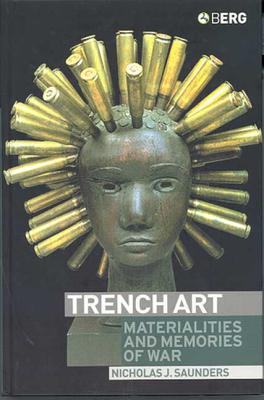Trench art is the evocative name given to a dazzling array of objects made from the waste of industrialized war. This long overdue study offers an original and informative look at one of the most arresting forms of art. Spanning from 1800 to the present day, its analysis of art, human experience, and warfare will pave the way for new research.
Trench art is the evocative name given to a dazzling array of objects made from the waste of industrialized war. Each object, whether an engraved shell case, cigarette lighter or a pen made from shrapnel, tells a unique and moving story about its maker. For the first time, this book explores in-depth the history and cultural importance behind these ambiguous art forms. Not only do they symbolize human responses to the atrocities of war, but they also act as mediators between soldiers and civilians, individuals and industrial society, and, most importantly, between the living and the dead. Trench art resonates most obviously with the terror of endless bombardment, night raids, gas attacks and the bestial nature of trench life. It grew in popularity between 1919 and 1939 when the bereaved embarked on battlefield pilgrimages and returned with objects intended to keep alive the memory of loved ones. The term trench art is, however, misleading, as it does not simply refer to materials found in the trenches. It describes a diverse range of objects that have in some way emerged from the experience of war all over the world. Many distinctive objects, for example, were made during conflicts in Bosnia, Vietnam, Northern Ireland and Korea. Surprisingly, trench art predates World War I and it can be made in a number of earlier wars such as the Crimean War, the American Civil War, and the Boer War. Saunders looks at the broader issues of what is meant by trench art, what it was before the trenches and how it fits in with other art movements, as well as the specific materials used in making it. He suggests that it can be seen as a bridge between the nineteenth century certainties and the fragmented industrialized values and ideals of the modern world. This long overdue study offers an original and informative look at one of the most arresting forms of art. Spanning from 1800 to the present day, its analysis of art, human experience, and warfare will pave the way for new research
Get Trench Art by at the best price and quality guranteed only at Werezi Africa largest book ecommerce store. The book was published by Taylor & Francis Ltd and it has pages. Enjoy Shopping Best Offers & Deals on books Online from Werezi - Receive at your doorstep - Fast Delivery - Secure mode of Payment
 Jacket, Women
Jacket, Women
 Woolend Jacket
Woolend Jacket
 Western denim
Western denim
 Mini Dresss
Mini Dresss
 Jacket, Women
Jacket, Women
 Woolend Jacket
Woolend Jacket
 Western denim
Western denim
 Mini Dresss
Mini Dresss
 Jacket, Women
Jacket, Women
 Woolend Jacket
Woolend Jacket
 Western denim
Western denim
 Mini Dresss
Mini Dresss
 Jacket, Women
Jacket, Women
 Woolend Jacket
Woolend Jacket
 Western denim
Western denim
 Mini Dresss
Mini Dresss
 Jacket, Women
Jacket, Women
 Woolend Jacket
Woolend Jacket
 Western denim
Western denim
 Mini Dresss
Mini Dresss






























































